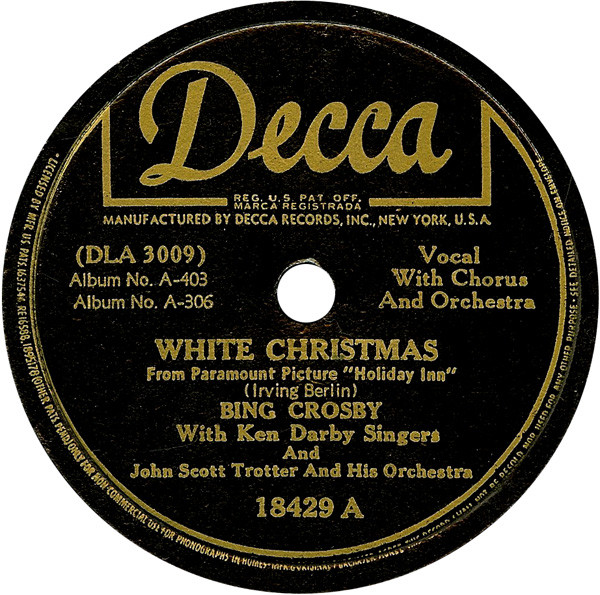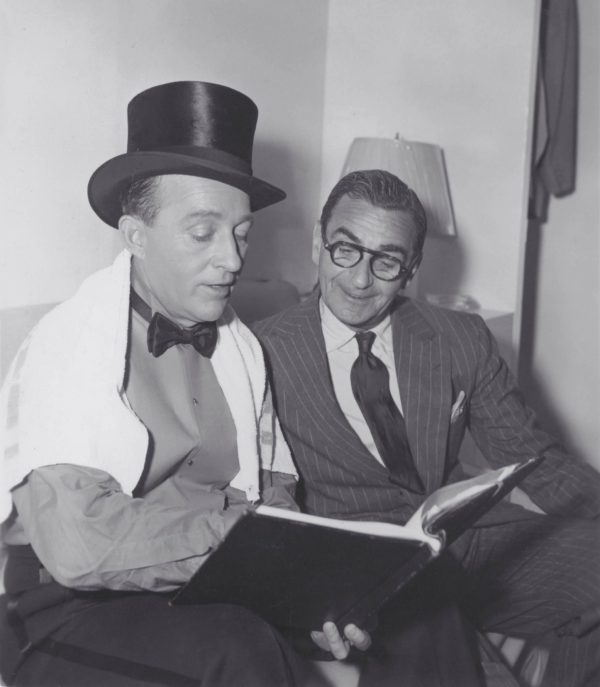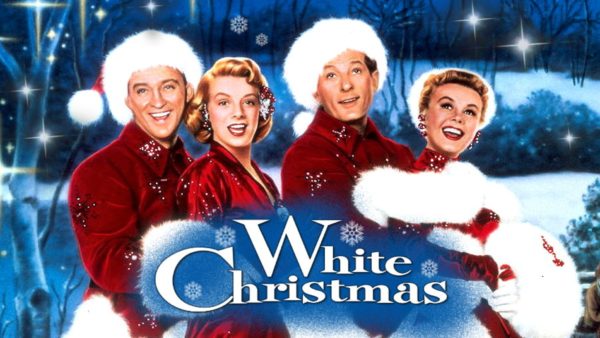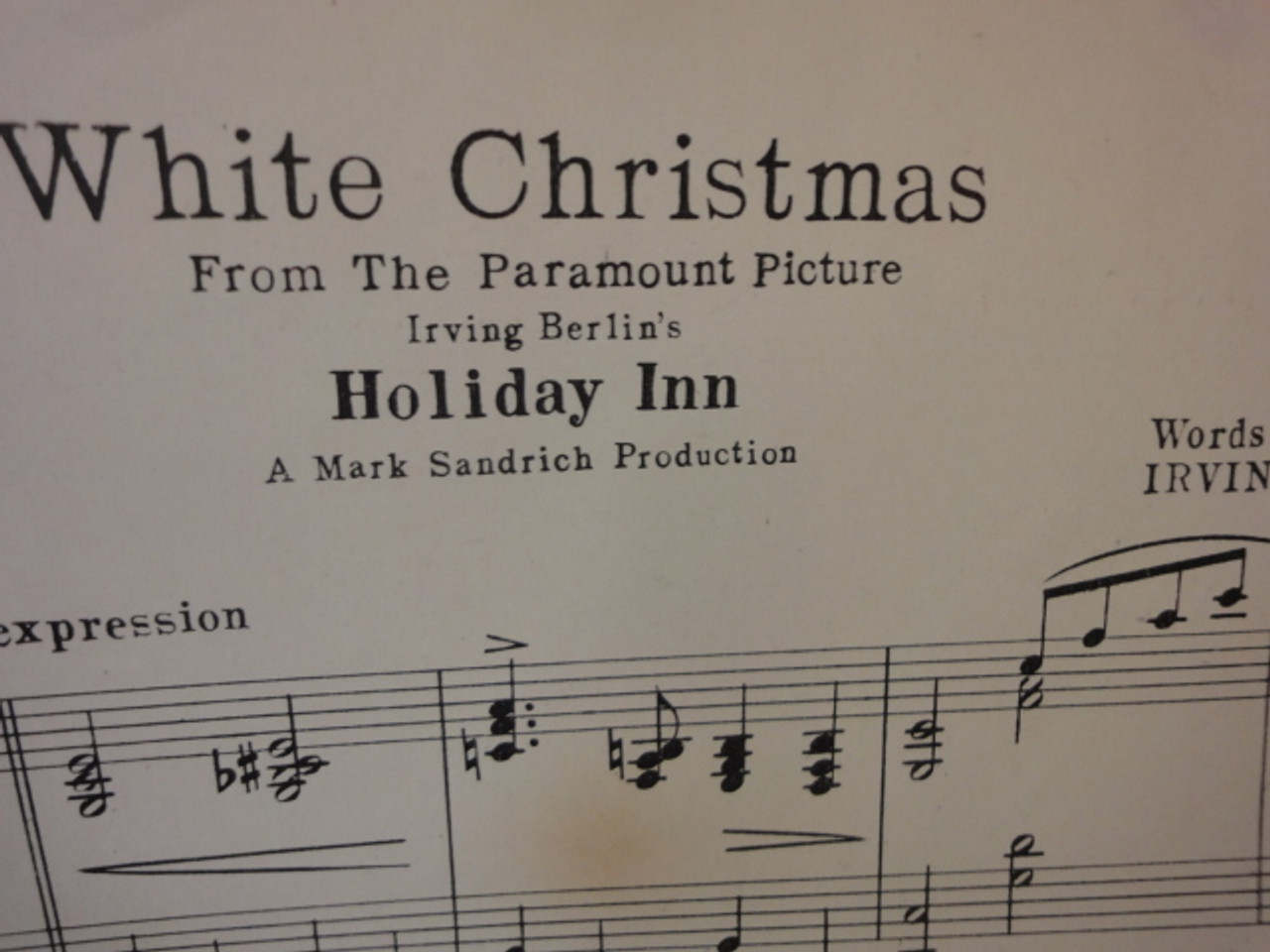Eighty Years of White Christmas
The most enduring of Christmas carols just might be Bing Crosby’s 1942 version of Irving Berlin’s “White Christmas”, celebrating its eightieth year this holiday season. Even in this day of flash-in-the-pan one-hit-wonders, streaming and digital downloads, Crosby’s classic retains its lofty perch as the world’s best-selling single, with global sales exceeding fifty million. But it’s not just Crosby – add in the sales figures of the hundreds of artists who have covered the tune, and total sales of “White Christmas” double to over 100 million! Perhaps writer/composer Irving Berlin’s post-creation assessment of the tune for his secretary was correct: “I want you to take down a song I wrote over the weekend. Not only is it the best song I ever wrote, it’s the best song anybody ever wrote.”
Despite the hoopla, there’s some mystery about exactly where and when Berlin penned his classic; written perhaps as early as 1940, the song was incorporated into the movie “Holiday Inn” in 1942, and won that year’s Academy Award for Best Original Song. Regardless, the first public performance was by Crosby on Christmas Day 1941 on his NBC radio program “The Kraft Music Hall”. Few copies of that performance still exist, and the version so ubiquitous every December was recorded in 18 minutes on 29 May 1942, later released on the “Holiday Inn” soundtrack July 30th of that year.

A look at the charts of Berlin, Crosby, and dates significant to the song show a clear connection between asteroids depicting the holiday season and the melody that has become so associated with it. We’ll be using asteroids Irvine and Berlind for Irving Berlin, Crosby for Bing Crosby, Yule and Carol for Christmas songs generally, and White and Schneeweis (German for “white snow”) for the song’s main theme.
Born 11 May 1888 (no time available) Irving Berlin is perhaps the best-known Jewish composer of Christmas songs, an irony in itself. Berlin’s 21 Taurus Sun is an exact match for Mercury, and also conjoined Neptune at 29 Taurus, so a knack for lyrics (Mercury) and tunes (Neptune) was inborn. Also here is asteroid Carol at 20 Taurus, making a Christmas song somehow self-defining for Berlin, and “White Christmas” is certainly among the most popular compositions in his musical legacy.
The Sun opposes asteroid Berlind at 26 Scorpio, a common placement for one’s own PNA (Personal-Named Asteroid), which typically aspects the Sun, Moon, Ascendant or Mercury. On the fulcrum of a T-Square is asteroid Schneeweis at 20 Leo, exactly squared Carol, conjuring images of a holiday song focused on snow. Also in square to the Sun/Mercury/Carol grouping (but too wide for Neptune and Berlind) is asteroid Yule at 13 Leo, linking Berlin directly with the season, despite his Hebraic roots.

Asteroid White at 27 Capricorn is slowing as it approaches its station, gathering momentum, but not quite at the degree; trine the Sun, it forms an out-of-Sign Grand Trine with asteroid Irvine, which at 3 Libra is stationary, turning direct four days after Berlin’s birth. White is also closely squared to asteroid Crosby at 29 Aries, which reaches out to Venus and asteroid Singer, at 4 and 6 Taurus respectively, combining “White Christmas”’s most famous performing artist with his role in its presentation (Singer) and the ancient ruler of entertainment, including music (Venus).
Similarly, Bing Crosby (born 3 May 1903, no time available) also has asteroid White trine the Sun, but not quite at its station degree. At 6 Virgo, White does trine Berlin’s asteroid Singer exactly, and in Crosby’s chart it is exactly semisextile asteroid Crosby at 6 Libra, establishing Crosby as a noted crooner of his day, while simultaneously setting him up as the vehicle for “White Christmas”’s success.
Crosby’s 11 Taurus Sun is conjoined by asteroid Yule at 8 Taurus and opposes asteroid Carol at 16 Scorpio: a Christmas song (Yule, Carol) is self-defining (Sun) for him, with “White Christmas” the performance for which he is best remembered. Asteroid Singer at 11 Cancer is exactly sextile the Sun and opposes asteroid Berlind at 13 Capricorn, trine the Sun, which is at station, turning retrograde a week later. Berlind’s stationary status shows an important, pivotal role to play in Crosby’s life for the “White Christmas” composer, heightened by the Grand Trine Kite pattern formed from the Sun/Yule conjunction, asteroids White and Berlind, with asteroid Carol on the String.

Asteroid Irvine at 19 Gemini is closely bound up with the exact Venus/Pluto pairing at 18 Gemini, suggesting Berlin (Irvine) had a powerfully transformative (Pluto) influence on Crosby’s musical output (Venus). (Regrettably, Venus/Pluto also has a lot to say about Crosby’s pattern of domestic abuse.)
Crosby’s first public performance of “White Christmas” on 25 December 1941 shows a stationary asteroid Irvine at 9 Virgo trine the 3 Capricorn Sun with Mercury 5 Capricorn Squared these is asteroid Yule at 6 Libra, showcasing the holiday season.
Asteroid Crosby at 23 Aquarius is closely squared by asteroid White at 24 Scorpio, and involved in a loose Grand Trine Kite pattern, with trines to asteroids Carol at 29 Libra and Schneeweis at 20 Gemini, with asteroid Berlind on the String at 19 Sagittarius. Even the Kraft Music Hall venue gets in on the act, with asteroid Kraft at 22 Capricorn squared Carol, for the first public performance of what would become a yuletide classic.

The pattern of a stationary Irving-Berlin-related PNA continues with the recording date for “White Christmas”, with asteroid Berlind again at station from 1 Aquarius, having turned retrograde the day before the May 29th taping. Trine the Sun at 7 Gemini, Berlind is assisted by asteroid Irvine at 4 Virgo, in square, to further identify the composer. Saturn participates from 2 Gemini, conjunct the Sun, lending a clue to the song’s longevity.
Asteroid Carol at 26 Libra exactly opposes Venus at 26 Aries, combining a holiday tune with the planet ruling entertainment, and conferring popular reception (also Venus); asteroid Schneeweis at 19 Cancer with Mars at 20 Cancer lies on the fulcrum of a T-Square, energizing the performance. Neptune and asteroid Yule collude at 27 and 28 Virgo, squared to a Mercury/Jupiter pairing at 25 and 27 Gemini. This brings together a seasonal (Yule) melody (Neptune) and lyrics (Mercury) with an expansive energy (Jupiter), yielding a memorable (Mercury) holiday song (Yule/Neptune).

Asteroid Crosby at 24 Taurus squares asteroid Singer at 19 Leo, once again identifying Crosby’s role in the process. Asteroid White at 5 Capricorn is inconjunct Sun/Saturn and trine Irvine.
“White Christmas”’s release in a form accessible to the public came on July 30, 1942, with the “Holiday Inn” soundtrack. The 6 Leo Sun is in a stellium with Mercury at 2, Pluto at 5, and Schneeweis at 12 Leo. Neptune remains at 7 Virgo, joined now by asteroids Singer at 20 Virgo and Irvine at 28, all in square to a stationary asteroid White at 22 Sagittarius, which turned direct a week later. Asteroid Crosby at 1 Cancer squares these, out-of-Sign. Asteroid Berlind at 22 Capricorn squares both Yule at 13 Libra and Carol at 29 Libra, bringing together the pairing which spells out “Christmas” (Yule) carol (Carol)”, but are just a bit wide to otherwise be considered conjunct.
Even the “White Christmas” Oscar nod can be seen in the stars, with presages of winning in Irving Berlin’s chart and its recording. Berlin’s natal asteroid Nike, named for the Greek goddess of victory, is exactly conjunct asteroid White at 27 Capricorn, while asteroid Victoria, named for her Roman counterpart, appears at 19 Leo, conjoined both Schneeweis at 20 Leo and Yule at 13 Leo. This suggests some sort of accolade, award or “win” (Nike, Victoria) involving something white (White), snowy (Schneeweis), or holiday-themed (Yule).

Asteroid Oskar (for the Oscars) at 14 Aries trines the Leo group, refining what particular award is in the offing. An exact conjunction of asteroid Academia (for the Academy of Motion Picture Arts & Sciences, which sponsors the awards) with the Sun/Mercury pairing at 21 Taurus indicates a writing (Mercury) award (Academia) that is somehow self-defining (Sun); asteroid Carol here at 20 Taurus reiterates the Christmassy tie-in.
When recorded by Crosby on 29 May 1942, asteroid Academia at 9 Gemini conjoins the Sun/Saturn pairing at 7 and 2 Gemini, and opposes Nike at 13 Sagittarius, clearly signaling potential for an Oscar win. As well, asteroid Victoria at 6 Libra, trine the Sun, is stationary (turning direct four days prior), powerfully embedding that “winning” vibe in its essence. The icing on the cake is asteroid Oskar, exactly conjoined asteroid Crosby at 24 Taurus.
The Oscars for 1942 were presented on 4 March 1943, with asteroid Oskar at 22 Cancer conjunct Greater Benefic Jupiter at 15 Cancer, opposed a cluster of asteroids Singer, Irvine and Yule at 10, 19 and 20 Capricorn, with asteroid Schneeweis at 22 Libra on the fulcrum of a T-Square, neatly encapsulating the circumstances. Berlin himself was highlighted for the day, with asteroid Berlind at 11 Pisces conjoined the spotlighting Sun at 13 Pisces. Bing Crosby receives celestial acknowledgment in the form of asteroid Crosby at 19 Leo, sextile to Schneeweis, with both points inconjunct to asteroid White at 24 Pisces on the Apex of a Yod, or Finger of Destiny. Crosby also opposes asteroid Victoria at 26 Aquarius, putting the crooner in a winning position. Asteroid Academia at 5 Leo opposed asteroids Carol and Nike at 2 and 6 Aquarius foreshadows the Academy’s (Academia) preference for a Christmas song (Carol) win (Nike).

“White Christmas” was a smash hit for Crosby, and became an instant holiday classic. Its popularity was such that in 1954 Paramount built an entirely new movie around it, the eponymous “White Christmas”, starring Crosby and Danny Kaye. The original Bing Crosby version remains in the forefront of lists of popular Christmas carols, eighty years after its release, still consistently scoring in the top ten, and new versions are recorded annually, assuring an enduring place in yuletide celebrations for “White Christmas”.
Here’s to another eighty years of “the best song anybody ever wrote”!


3 comments, add yours.
Karen
All so interesting. I second that… here’s to another 80 years! Thank you.
Laurien
Beautiful! It really is the best song anybody ever wrote and reading about it has put me in the holiday spirit! Thanks Alex and Merry Christmas, whether it’s white or not!
Emma Esperanza Acosta Vásquez
Gracias por la historia y la relación con los asteroides.